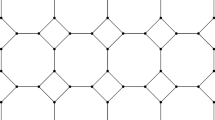Abstract
We study the limit shape of successive coronas of a tiling, which models the growth of crystals. We define basic terminologies and discuss the existence and uniqueness of corona limits, and then prove that corona limits are completely characterized by directional speeds. As an application, we give another proof that the corona limit of a periodic tiling is a centrally symmetric convex polyhedron [see Zhuravlev (St Petersbg Math J 13(2):201–220, 2002) and Maleev and Shutov (Layer-by-layer growth model for partitions, packings, and graphs, Tranzit-X, Vladimir, 2011)].

Similar content being viewed by others
Notes
References
Akiyama, S., Brunotte, H., Pethő, A., Thuswaldner, J.M.: Generalized radix representations and dynamical systems III. Osaka J. Math. 45(2), 347–374 (2008)
Akiyama, S., Imai, K.: The corona limit of Penrose tilings is a regular decagon. In: Proceedings of the 22nd International Workshop on Cellular Automata and Discrete Complex Systems (AUTOMATA’16). Lecture Notes in Computer Science, vol. 9664, pp. 35–48. Springer, Cham (2016)
Baake, M., Grimm, U.: Coordination sequences for root lattices and related graphs. Z. Kristallogr. 212(4), 253–256 (1997)
Baake, M., Grimm, U.: Averaged coordination numbers of planar aperiodic tilings. Philos. Mag. 86(3–5), 567–572 (2006)
Bennema, P., van der Eerden, J.P.: Crystal graphs, connected nets, roughening transition and the morphology of crystals. In: Sunagawa, I. (ed.) Morphology of Crystals, Part A, pp. 1–75. Terra, Tokyo (1987)
Böröczky Jr., K., Schnell, U.: Wulff shape for nonperiodic arrangements. Lett. Math. Phys. 45(1), 81–94 (1998)
Bravais, A.: Les systemes formes par des pointes distributes regulierement sur un plan ou dans l’espace. J. Ecole Polytech. XIX, 1–128 (1850)
Chernov, A.A.: The kinetics of the growth forms of crystals. Sov. Phys. Crystallogr. 7, 728–730 (1963)
Conway, J.B.: A Course in Functional Analysis. Graduate Texts in Mathematics, vol. 96. Springer, New York (1985)
Donnay, J.D.H., Harker, D.: A new law of crystal morphology extending the law of Bravais. Amer. Miner. 22, 446–467 (1937)
Grünbaum, B., Shephard, G.C.: Tilings and Patterns. W.H. Freeman and Company, New York (1987)
Hartman, P., Perdok, W.G.: On the relations between structure and morphology of crystals I. Acta Crystallogr. 8, 49–52 (1955)
Kechris, A.S.: Classical Descriptive Set Theory. Graduate Texts in Mathematics, vol. 156. Springer, New York (1995)
Kolmogorov, A.N.: On the “geometrical selection” of crystals. Dokl. Akad. Nauk SSSR 65, 681–684 (1949)
Maleev, A.V., Shutov, A.V.: Layer-by-Layer Growth Model for Partitions, Packings, and Graphs. Tranzit-X, Vladimir (2011) (in Russian)
Maleev, A.V., Shutov, A.V., Zhuravlev, V.G.: 2D quasi-periodic Rauzy tiling as a section of 3D periodic tiling. Crystallogr. Rep. 55(5), 723–733 (2010)
Schnell, U.: Wulff-shape and density deviation. Geom. Dedicata 79(1), 51–63 (2000)
Shutov, A.V., Maleev, A.V.: Inverse problem in the layer-by-layer growth model. Crystallogr. Rep. 59(6), 855–861 (2014)
Shutov, A.V., Maleev, A.V.: Layer-by-layer growth of vertex graph of Penrose tiling. Crystallogr. Rep. 62(5), 683–691 (2017)
Shutov, A.V., Maleev, A.V., Zhuravlev, V.G.: On layer-by-layer growth model for tilings and graphs. In: Proceedings of the 5th All-Russia Scientific School Mathematical Research in Natural Sciences, pp. 126–130. Apatity, GI RAN (2009)
Simon, B.: Convexity: An Analytic Viewpoint. Cambridge Tracts in Mathematics, vol. 187. Cambridge University Press, Cambridge (2011)
Sunagawa, I.: Growth and morphology of crystals. Forma 14, 147–166 (1999)
Walters, P.: An Introduction to Ergodic Theory. Graduate Texts in Mathematics, vol. 79. Springer, New York (1982)
Wulff, G.: Zur Frage der Geschwindigkeit des Wachsturms und der Auflösung der Kristallflächen. Z. Kristallogr. 34, 449–530 (1901)
Zhuravlev, V.G.: Self-similar growth of periodic partitions and graphs. St. Petersbg. Math. J. 13(2), 201–220 (2002)
Zhuravlev, V.G., Maleev, A.V.: Layer-by-layer growth of quasi-periodic Rauzy tiling. Crystallogr. Rep. 52(2), 180–186 (2007)
Acknowledgements
We express our cordial gratitude to A.V. Shutov for informing us of the current status of the research on corona limits and for providing us some of the references, which are not easily accessible. We are also largely indebted to the anonymous referee and Fumihiko Nakano who gave us invaluable suggestions and related references. The first author is partially supported by JSPS Grants (17K05159, 17H02849, BBD30028). The third author is partially supported by JSPS Grants (26330016, 17K00015). The fourth author is supported by JSPS Grant (15K17505).
Author information
Authors and Affiliations
Corresponding author
Additional information
Editor in Charge: Kenneth Clarkson
Appendices
Appendix A: 1-Uniform Tilings and Velocities
Computation of corona limits of 1-uniform tilings using point adjacency and edge adjacency, see Remark 2.1 and Sect. 6. Each row consists of five figures: tiling, (finite) coronas, their velocities, (finite) edge-coronas and their velocities. The convex hull of velocities is the corona limit, see Theorem 5.1 and the description after it.


Appendix B: 2-Uniform Tilings and Velocities
The same computation of corona limits of 2-uniform tilings. Each tiling is designated by two vertex configurations joined by semi-colon.




Rights and permissions
About this article
Cite this article
Akiyama, S., Caalim, J., Imai, K. et al. Corona Limits of Tilings: Periodic Case. Discrete Comput Geom 61, 626–652 (2019). https://doi.org/10.1007/s00454-018-0033-x
Received:
Revised:
Accepted:
Published:
Issue Date:
DOI: https://doi.org/10.1007/s00454-018-0033-x




